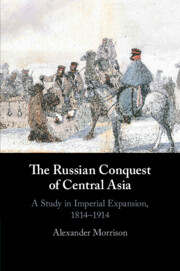Book contents
- The Russian Conquest of Central Asia
- The Russian Conquest of Central Asia
- Copyright page
- Dedication
- Contents
- Illustrations
- Maps
- Tables
- Acknowledgements
- Note on Translation, Transliteration and Dates
- Abbreviations
- Glossary
- Maps
- Introduction
- 1 Russia’s Steppe Frontier and the Napoleonic Generation
- 2 ‘Pray for the Camels’: The Winter Invasion of Khiva, 1839–41
- 3 ‘This Particularly Painful Place’: The Failure of the Syr-Darya Line as a Frontier, 1841–63
- 4 From Ayaguz to Almaty: The Conquest and Settlement of Semirechie, 1843–82
- 5 The Search for a ‘Natural’ Frontier and the Fall of Tashkent, 1863–5
- 6 War with Bukhara, 1866–8
- 7 The Fall of Khiva, 1872–3
- 8 ‘Those Who Should Be Spared’: The Conquest of Ferghana, 1875–6
- 9 ‘The Harder You Hit Them, the Longer They Will Be Quiet Afterwards’: The Conquest of Transcaspia, 1869–85
- 10 Aryanism on the Final Frontier of the Russian Empire: The Exploration and Annexation of the Pamirs, 1881–1905
- Epilogue: After the Conquest
- Sources and Bibliography
- Index
4 - From Ayaguz to Almaty: The Conquest and Settlement of Semirechie, 1843–82
Published online by Cambridge University Press: 19 November 2020
- The Russian Conquest of Central Asia
- The Russian Conquest of Central Asia
- Copyright page
- Dedication
- Contents
- Illustrations
- Maps
- Tables
- Acknowledgements
- Note on Translation, Transliteration and Dates
- Abbreviations
- Glossary
- Maps
- Introduction
- 1 Russia’s Steppe Frontier and the Napoleonic Generation
- 2 ‘Pray for the Camels’: The Winter Invasion of Khiva, 1839–41
- 3 ‘This Particularly Painful Place’: The Failure of the Syr-Darya Line as a Frontier, 1841–63
- 4 From Ayaguz to Almaty: The Conquest and Settlement of Semirechie, 1843–82
- 5 The Search for a ‘Natural’ Frontier and the Fall of Tashkent, 1863–5
- 6 War with Bukhara, 1866–8
- 7 The Fall of Khiva, 1872–3
- 8 ‘Those Who Should Be Spared’: The Conquest of Ferghana, 1875–6
- 9 ‘The Harder You Hit Them, the Longer They Will Be Quiet Afterwards’: The Conquest of Transcaspia, 1869–85
- 10 Aryanism on the Final Frontier of the Russian Empire: The Exploration and Annexation of the Pamirs, 1881–1905
- Epilogue: After the Conquest
- Sources and Bibliography
- Index
Summary
By the end of the nineteenth century Semirechie would be known as the ‘granary of Central Asia’, and the only significant Russian settler colony in Turkestan, but in the 1840s it was still largely populated by Kyrgyz and Qazaq nomadic pastoralists under the contested rule of the Khoqand Khanate. Russian contacts with Qazaq Chinggissids of the Great Horde dated back to the early 1800s, but a Russian military presence came only in the 1840s, with the construction of fortresses at Kopal and Lepsinsk, before they crossed the Ili river to found Fort Vernoe in 1854. In 1860 Khoqandi forces suffered a shattering defeat at the Battle of Uzun-Agach, paving the way for extensive Cossack and peasant settlement in Semirechie’s gentle climate. In 1871 the Russians seized the Upper Ili Valley, which had seen a rebellion against Chinese rule in 1866. In 1881, however, following the reconquest of the region by the Qing, they returned the territory to them – the only instance of this happening throughout the whole history of the conquest.
- Type
- Chapter
- Information
- The Russian Conquest of Central AsiaA Study in Imperial Expansion, 1814–1914, pp. 168 - 215Publisher: Cambridge University PressPrint publication year: 2020

